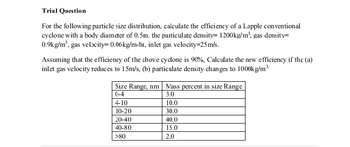
Structural Analysis
6th Edition
ISBN: 9781337630931
Author: KASSIMALI, Aslam.
Publisher: Cengage,
expand_more
expand_more
format_list_bulleted
Concept explainers
Question
thumb_up100%
For the following particle size distribution, calculate the efficiency of a Lapple conventional
cyclone with a body diameter of 0.5m. the particulate density= 1200kg/m3
, gas density=
0.9kg/m3
, gas velocity= 0.06kg/m-hr, inlet gas velocity=25m/s.
Assuming that the efficiency of the above cyclone is 90%, Calculate the new efficiency if the (a)
inlet gas velocity reduces to 15m/s, (b) particulate density changes to 1000kg/m3.
Size Range, nm Mass percent in size Range
0-4
3.0
4-10
10.0
10-20
30.0
20-40
40.0
40-80
15.0
>80
2.0

Transcribed Image Text:Trial Question
For the following particle size distribution, calculate the efficiency of a Lapple conventional
cyclone with a body diameter of 0.5m. the particulate density= 1200kg/m³, gas density=
0.9kg/m³, gas velocity= 0.06kg/m-hr, inlet gas velocity=25m/s.
Assuming that the efficiency of the above cyclone is 90%, Calculate the new efficiency if the (a)
inlet gas velocity reduces to 15m/s, (b) particulate density changes to 1000kg/m³.
Size Range, nm
0-4
4-10
10-20
20-40
40-80
>80
Mass percent in size Range
3.0
10.0
30.0
40.0
15.0
2.0
Expert Solution
This question has been solved!
Explore an expertly crafted, step-by-step solution for a thorough understanding of key concepts.
This is a popular solution
Trending nowThis is a popular solution!
Step by stepSolved in 4 steps

Knowledge Booster
Learn more about
Need a deep-dive on the concept behind this application? Look no further. Learn more about this topic, civil-engineering and related others by exploring similar questions and additional content below.Similar questions
- Calculate the pressure drop for the cyclone of Problem 4,2, assuming K =14,arrow_forwardThe three statements below all refer to standard single-barrel reverse flow cyclones used to remove particulate matter from air. For each statement, indicate whether it is True or False and explain your reasoning. a) If a cyclone has a collection efficiency of 25% for a specific-sized particle, then it can be expected always to have a collection efficiency of 50% if the particle size doubles, assuming all else remains constant. b) If a cyclone has a collection efficiency of 25% for a particle having a specified density, then it can be expected always to have a collection efficiency of 50% if the particle density doubles, assuming all else remains constant. c) To a single decimal place, the effective number of turns made in traversing a standard cyclone is always 37.7, independent of the cyclone size and air flow rate into the cyclone.arrow_forwardWhat diameter would a circular clarifier have to be to remove 50 μm particles with 75% efficiency from a 4 MGD (million gallon per day) flow? Assume the particle specific gravity is 1.5 and the temperature is 10°C. Answer: 18 marrow_forward
- Calculate the aerosol scavenging coefficient ^ as a function of the diameter d of the scavenged particle over a size range of P 0.01 -0.1μm diameter for drops of diameter D = 5mm P falling at their terminal velocity in the air at 25°C. Assume that P = 1mmh¹ 0arrow_forwardThe absolute viscosity of the peanut oil is 41x10-3 Pa-s and the specific gravity is 0.95. If the discharge is 8.6 L/s, what is the associated Reynolds number at the throat of the Venturi meter for a throat diameter of 51 mm?arrow_forward
arrow_back_ios
arrow_forward_ios
Recommended textbooks for you

 Structural Analysis (10th Edition)Civil EngineeringISBN:9780134610672Author:Russell C. HibbelerPublisher:PEARSON
Structural Analysis (10th Edition)Civil EngineeringISBN:9780134610672Author:Russell C. HibbelerPublisher:PEARSON Principles of Foundation Engineering (MindTap Cou...Civil EngineeringISBN:9781337705028Author:Braja M. Das, Nagaratnam SivakuganPublisher:Cengage Learning
Principles of Foundation Engineering (MindTap Cou...Civil EngineeringISBN:9781337705028Author:Braja M. Das, Nagaratnam SivakuganPublisher:Cengage Learning Fundamentals of Structural AnalysisCivil EngineeringISBN:9780073398006Author:Kenneth M. Leet Emeritus, Chia-Ming Uang, Joel LanningPublisher:McGraw-Hill Education
Fundamentals of Structural AnalysisCivil EngineeringISBN:9780073398006Author:Kenneth M. Leet Emeritus, Chia-Ming Uang, Joel LanningPublisher:McGraw-Hill Education
 Traffic and Highway EngineeringCivil EngineeringISBN:9781305156241Author:Garber, Nicholas J.Publisher:Cengage Learning
Traffic and Highway EngineeringCivil EngineeringISBN:9781305156241Author:Garber, Nicholas J.Publisher:Cengage Learning


Structural Analysis (10th Edition)
Civil Engineering
ISBN:9780134610672
Author:Russell C. Hibbeler
Publisher:PEARSON

Principles of Foundation Engineering (MindTap Cou...
Civil Engineering
ISBN:9781337705028
Author:Braja M. Das, Nagaratnam Sivakugan
Publisher:Cengage Learning

Fundamentals of Structural Analysis
Civil Engineering
ISBN:9780073398006
Author:Kenneth M. Leet Emeritus, Chia-Ming Uang, Joel Lanning
Publisher:McGraw-Hill Education


Traffic and Highway Engineering
Civil Engineering
ISBN:9781305156241
Author:Garber, Nicholas J.
Publisher:Cengage Learning